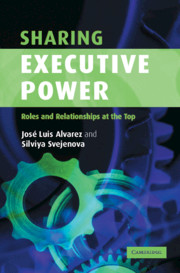Conclusion: From small numbers to corporate governance regimes
Published online by Cambridge University Press: 22 September 2009
Summary
“Do you know,” I said, “that it is necessary that there also be as many forms of human characters as there are forms of regimes? Or do you suppose that the regimes arise ‘from an oak or rocks’ and not from the dispositions of the men in the cities, which, tipping the scale as it were, draw the rest along with them?”
“No,” he said. “I don't at all think they arise from anything other than this.”
Plato, The Republic, Book VIII, 543 e.Much has been written on solo structures and executive roles. However, as argued in the Introduction, a book on duos, trios, and larger executive constellations that share governance positions is timely. In Part II of the book we situated the phenomenon of small numbers at the top in the field of organization studies and outlined its most relevant debates. We also introduced our two main theoretical lenses – contingency theory and role theory – through which we investigate the phenomenon. In Part I of the book we concentrated on the phenomenon itself, undertaking a presentation and discussion of examples of the basic types of small-numbers structures: professional duos, trios, and larger constellations. We also delved into the domain of career theories, seeking to grasp the particulars of executives' united careers, the most integrated case of small numbers.
- Type
- Chapter
- Information
- Sharing Executive PowerRoles and Relationships at the Top, pp. 203 - 224Publisher: Cambridge University PressPrint publication year: 2005



